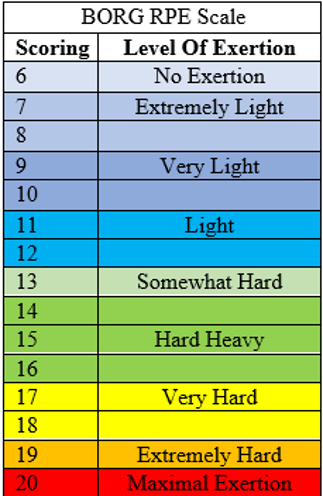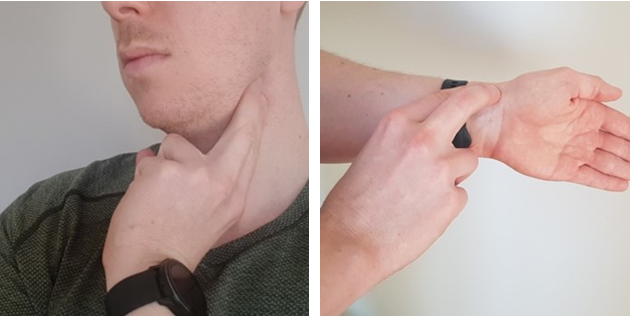
3 Ways To Self-Monitor Perceived Exertion During Exercise
Your shoes are tied, your water bottle is filled, and you are ready to get some exercise. The weather is predicting sunny skies and you have decided to get outdoors for a walk, jog, or a run. You are just getting into the pace of things when you find yourself wondering a specific question “how hard should I be working while I’m exercising?”. This is not a simple answer, however, through reading this article you will be able to apply 3 simple methods to self-monitor your perceived exertion levels during exercise.
Let’s first answer a few important questions.
What Is Perceived Exertion?
Perceived exertion can be defined as how hard you feel your body is working based on physical sensations experienced during exercise.
Why Is Monitoring Perceived Exertion Important During Exercise?
- It will help you keep safe while exercising to ensure you are not working too hard.
- It will help you get the most benefit from your exercise.
- It will help you track your progress with exercise.
What Sensations Should I Focus on When Determining My Perceived Exertion?
Try to draw your attention to multiple sensations rather than one specific sensation. Examples of sensations might include but are not limited to:
- How heavy you are breathing.
- How fast your heart is beating.
- How tired your muscles feel.
- The amount you are sweating.
3 Methods to Self-Monitor Your Perceived Exertion During Exercise
1. The Talk Test
If you are able to talk while exercising but not sing, you are most likely working at a level of moderate intensity physical activity.
If you are able to say only a few words at a time during exercise without pausing for a breath, you are likely working at a level of vigorous intensity physical activity.

TIP: If exercising with a friend, attempt to stay engaged in a two-way conversation. If you notice that your ability to verbally communicate is becoming either too easy or on the contrary too difficult, work towards increasing or decreasing the intensity level of your exercise.
2. Using The BORG Rating of Perceived Exertion Scale
This is a scale which can be used to provide a subjective measurement for rating of perceived exertion (RPE).
The scale ranges between 6 and 20.
Working at an intensity of 6 would suggest no exertion, while in contrast 20 would suggest a maximal exertion.
Why Does The Borg Scale start at 6 and not 1?
The scale ranks between 6 and 20 as it can be used as a tool to provide an estimate of your heart rate. To make this calculation, take your RPE and multiply it by 10.
Ex. 12 x 10 = 120 BPM

How Can I Implement This Scale Into My Exercise Routine?
Use the scale to monitor your RPE and try to determine where your exertion sits on the BORG scale the next time you are exercising.
Keep record of your BORG scores over time to track progress with exercise.
TIP: To reach a level of moderate intensity physical activity, it is recommended to aim towards working at 12-14 on the BORG scale. If while exercising you find your RPE to be below or above this range, you can work to adjust the intensity of your exercise to make it less or more challenging based on your RPE score.
3. Monitoring Your Heart Rate
Generally speaking, as the intensity of exercise increases so does the rate at which your heart beats. The reasoning for this is quite simple, as you work harder your heart must beat faster to supply more oxygen to the working muscles of your body. The takeaway from this is that you can use heart rate to measure your exertion during exercise.

Is This Method Right For Me?
If you are taking any medication to manage your blood pressure or heart rate, it is recommended that you utilize the talk test or BORG (RPE) rather than using this method for more accurate results.
How Do I Calculate My Heart Rate Using My Pulse?
First locate your pulse by gently pressing on the radial artery (located on the outside of your wrist), or the carotid artery (located on both sides of your neck).
Gently palpate one of these sites with the middle finger and index finger paired together until you feel a light thumping.

Count how many times your pulse is felt over the course of 15 seconds.
Take this number and multiply it by 4 to calculate how many times your heart beats per minute (BPM).
Ex. 30 Beats x 4 = 120 BPM.
How To Use Your Heart Rate To Monitor Physical Exertion
Once your heart rate has been calculated, you will then want to determine your Maximum Heart Rate and Target Heart Rate.
Maximum Heart Rate is the highest number of beats your heart can pump under maximum stress.
- Maximum Heart Rate can be calculated by inputting your age into the following formula.
- 220 – Age In Years = BPM
Your Target Heart Rate is the heart rate you are trying to achieve during exercise.
- Target Heart Rate can be obtained by calculating a percentage of your Maximum Heart Rate .
- Target Heart Rate can be calculated through the following formula:
- Maximum Heart Rate x Target Heart Rate % = Target Heart Rate BPM.
Putting It All Together Case Study
A 60 year old individual would first calculate their Maximum Heart Rate.
- 220 – 60 years = 160 BPM.
To work at a moderate intensity level, this individual would want to work towards keeping a target heart rate between 64%-76%.
- 160 BPM x 0.64 = 102 BPM.
- 160 BPM x 0.76 = 121 BPM.
This individual would then take this information and monitor their heart rate to stay in a range between 102 BPM and 121 BPM.
How Do I Know Which Method Is Best For Me?
All methods are good to use, however it is worth experimenting between all three to see what works best for you.
Use your preferred method as a tool in your toolbox when exercising.
How Can I Learn More?
Kinesiologists, Athletic Therapists and Physiotherapists can provide further education and assist you in monitoring your physical exertion during exercise.
CALL LIQUIDGYM TODAY TO BOOK WITH ONE OF OUR HEALTH PROFESSIONALS
TO GET YOU BACK TO FEELING GREAT AGAIN!
613-820-8228
References:
- Centers for Disease Control and Prevention website, “Target Heart Rate & Estimated Maximum Heart Rate,” found at https://www.cdc.gov/physicalactivity/basics/measuring/heartrate.htm
- Centers for Disease Control and Prevention website, “Perceived Exertion,” found at https://www.cdc.gov/physicalactivity/basics/measuring/exertion.htm
- Centers for Disease Control and Prevention website, “Measuring Physical Activity Intensity,” found at https://www.cdc.gov/physicalactivity/basics/measuring/index.html
- American College of Sports Medicine. (2010). ACSM’s guidelines for exercise testing and prescription 8th Philadelphia : Lippincott Williams & Wilkins,
Author:
Samuel Dick
Registered Kinesiologist